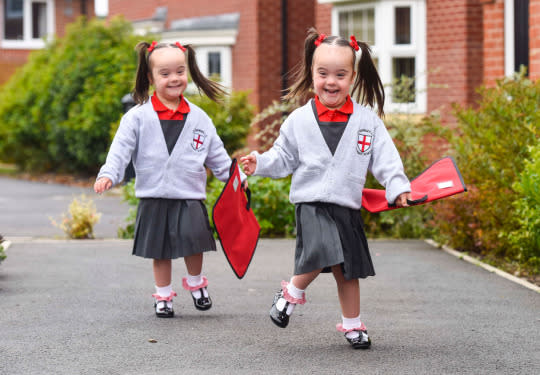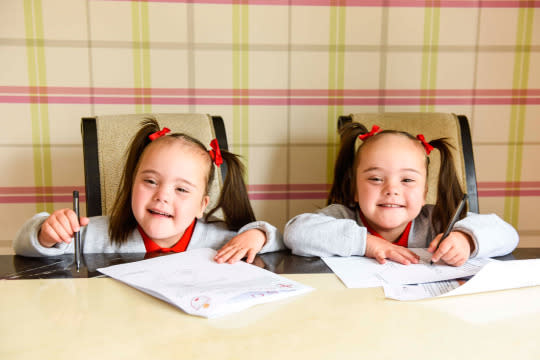Twin-credible! Two-Million-To-One Down’s Syndrome Sisters Celebrate First Day Of School

(Happy Abigail and Isobel were all smiles on their first day. Image: Caters)
Identical twins, who were born with Down’s syndrome at odds of two million to one, celebrated a milestone their parents feared they may never reach.
Adorable four-year-olds Abigail and Isobel Parry were all smiles on their first day of school.
They were diagnosed with the genetic condition three weeks after their premature birth in June 2011.
Parents Matt and Jodi admit that at first they thought it was “a life sentence”. But now they devote their lives to busting myths and misconceptions about Down’s.
They launched the Twincess Campaign to provide prospective or new parents of children with the syndrome frank non-judgemental advice.
They were shocked to discover that 92 percent of women with an antenatal diagnosis of Down’s, terminate their pregnancies.
The gorgeous girls attend the same school in Chorley as their big brother Finlay, aged six.

(Proud parents Matt and Jodi with their adorable ‘twincesses’. Image: Caters)
Dad, Matt, said: “When the girls were born, we did not know if they would be able to go to a mainstream school.
“This just shows how far we have come in our own understanding of Down’s syndrome. We had misconceptions, which a lot of people have, and that is what we are trying to tackle.
“In sending Abigail and Isobel to a mainstream school, we have chosen to push them to succeed as much as we can, but we are not blind to the fact there are alternatives should they struggle.”
Their parents say they are no more difficult to look after than their brother and they enjoy everything from pony riding to football.
They go to school for half days and have a teaching assistant supporting them.
The pair primarily uses sign language to communicate, as they speak a handful of words. Their sign language vocabulary is equivalent to a child of the same age’s verbal vocabulary.
Mum, Jodie, added: “When I was told the girls had Down’s syndrome, I was devastated. I felt like someone had just ripped my heart out.
“But when the girls came home from hospital, it soon became very apparent that apart from a few extra appointments, they were no different to Finlay. It would maybe just take them a little longer to do things.”

(The cheeky pair are experts at communicating in sign language. Image: Caters)
CEO of the Down’s Syndrome Association, Carol Boys, explained how attitudes have changed about the abilities of children with Down’s. She said: “In the past, it was believed there were many things that children with Down’s syndrome could not do, when in fact they had never been given the opportunity to try.
“Children with Down’s syndrome can and do learn alongside their peers in their local mainstream primary school, despite the fact they may not learn things as quickly as their classmates.
“Increasingly, they will move on with their classmates to a mainstream secondary school, and many will leave with qualifications and go on to further education.”

 Yahoo News
Yahoo News 
